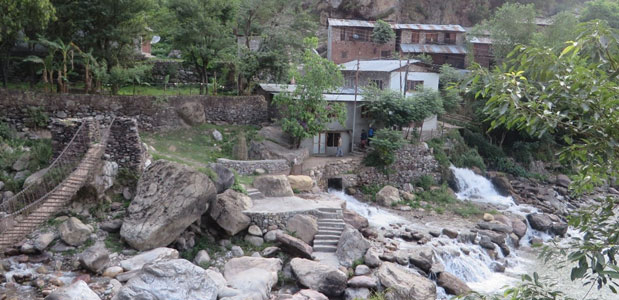By Anju Pandit

ICIMOD’s Himalayan Adaptation, Water, and Resilience (HI-AWARE) initiative is implementing three work packages – knowledge generation, research into use, and strengthening expertise in 12 study areas in the Indus, upper Ganga, Gandaki, and Teesta river basins. Micro hydropower, local communities, and benefit sharing comprise some of the components in a series of activities planned under HI-AWARE’s Research Component 3. Identifying opportunities and challenges in the sector of micro hydropower is one of the main deliverables of an ongoing research on energy under this initiative.
As part of documenting opportunities and challenges in the micro hydropower sector and understanding the possibilities for soft interventions, a field visit to Baglung was conducted in the first week of June 2016. Guided by baseline information provided by the district’s energy and environment unit, we visited three localities: Burtibang, Bongadovan, and Bhimgethi. During the visits, we assessed micro hydro plants and conducted a local-level consultation meeting with electricity producers, users, and entrepreneurs.
From the field investigation, it became clear that micro hydropower had become a blessing for many villages. While the majority of places in Nepal are feeling the impact of shortages in electricity, far-flung villages like Bongadovan and Bhimgethi are enjoying round-the-clock electricity. As a result, the communities in these villages were very motivated for the development and utilization of micro hydroelectric power, which has opened doors for economic activities in market hubs like Burtibang although villages like Bhimgethi and Bongadovan have not been able to utilize the surplus power efficiently.
At both of these latter sites, however, the scope for creating economic opportunities was palpable. If we could raise this issue in a timely manner with the Nepal Electricity Authority, Alternative Energy Promotion Centre, local residents, and the district development committee through stakeholder consultations, this could help channel local resources towards the right track. This consultation could happen in Kathmandu or Pokhara. Even making a small difference would be meaningful for the long-term sustainability of these localities.
At present, in Bongadovan, mismanagement in tariff collection is making things unnecessarily difficult for the locals. Supporting the locals to voice their grievances and accelerating tariff collection could help strengthen the fund management procedure. The fund, thus collected, could be utilized for the further development of the area, by installing streetlights, for instance, or establishing a revolving fund for female entrepreneurs. Overall, there is certainly scope for training the local people and building their capacity for increased economic activity.
